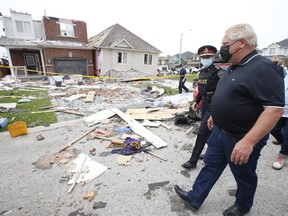
Today let’s examine how political and media-driven hysteria about climate change diverts us from real issues that we need to address.
Three recent reports by the Financial Accountability Office of Ontario headed by Peter Weltman illustrate the problem.
From our newsroom to your inbox at noon, the latest headlines, stories, opinion and photos from the Toronto Sun.
Thanks for signing up!
A welcome email is on its way. If you don't see it, please check your junk folder.
The next issue of Your Midday Sun will soon be in your inbox.
Last week, the FAO drew a key distinction between natural and human-induced climate change — rare for any government body — in reporting on the billions of dollars needed to maintain provincial and municipal public infrastructure in a state of good repair in the face of extreme weather events.
The FAO said the cost of maintaining Ontario’s $330-billion portfolio of publicly-owned transportation infrastructure in a so-called “stable” climate (that is, weather extremes due to natural climate change) will average $11 billion annually from 2022 to 2030, or $99 billion.
The cost due to extreme weather events caused by human-induced climate change will add $1.5 billion annually to that bill, the FAO said, for a total cost of $14 billion from 2022 to 2030.
While these calculations are estimates, the FAO’s distinction between the cost of maintaining public infrastructure due to natural climate change ($99 billion over nine years) versus the added cost of human-induced climate change ($14 billion over nine years) is important.
For one thing, it prevents politicians and the media — if they want to be accurate — from falsely claiming the FAO said human-induced climate change will cost Ontario taxpayers $12.5 billion annually until 2030 to keep publicly-owned transportation infrastructure in a state of good repair.
That’s not what the FAO said.
It said human-induced climate change — which began about 170 years ago when we started burning fossil fuels for energy on an industrial scale — will cost $1.5 billion a year in addition to the $11 billion annually caused by natural climate change — which has been going on for billions of years.
Climate change has always caused extreme weather events, long before human-induced climate change started adding to the damage.
The major problem in Ontario isn’t the added damage to public infrastructure caused by human-induced as opposed to natural climate change.
It’s that, as the FAO previously reported, Ontario has a deficit of almost $70 billion when it comes to keeping all forms of public infrastructure in a state of good repair.
Of that repair backlog, $52 billion is the responsibility of the province’s 444 municipal governments, while $16.8 billion is the responsibility of the provincial government.
Things are so disorganized, the FAO reported, that despite the importance of municipal infrastructure to the economy and society, a comprehensive dataset of municipal assets doesn’t even exist.
Based on its research, the FAO estimated 45% of all municipal infrastructure and 35% of all provincial infrastructure requires repairs, including almost half of the hospital sector.
Ontario’s problem of poorly-maintained public infrastructure developed over many decades, long before anyone was even taking about human-induced climate change.
If our municipal and provincial governments during that time had competently maintained and repaired publicly-owned infrastructure, the repair deficit wouldn’t be a major problem today, with or without human-induced climate change.
It’s true the cumulative costs of human-induced climate change will increase over time.
But it’s a relatively minor issue compared to the major one — the far more significant costs caused over many decades by the damage natural climate change has done to public infrastructure, which our provincial and municipal governments didn’t properly maintain.
That was the result of incompetence.
lgoldstein@postmedia.com


